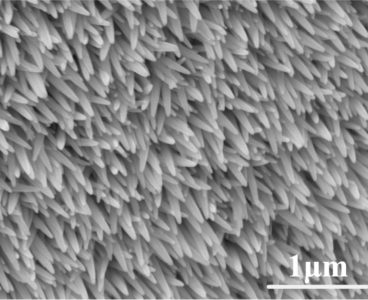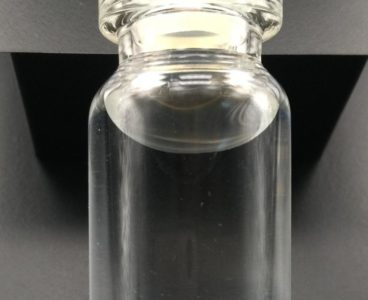DNA assembled into nanostructures such as tubes and origami-inspired shapes could someday find applications ranging from DNA computers to nanomedicine. However, these intriguing structures don’t persist long in biological environments because of enzymes called nucleases that degrade DNA. Now, researchers have designed DNA nanostructures that can heal themselves in serum. They report their results in…
Researchers Develop Wearable Sensor Inspired by Octopus Suckers
Wearable electronics that adhere to skin are an emerging trend in health sensor technology for their ability to monitor a variety of human activities, from heart rate to step count. But finding the best way to stick a device to the body has been a challenge. Now, a team of researchers reports the development of…
Transparent Wood can Store and Release Heat
Wood may seem more at home in log cabins than modern architecture, but a specially treated type of timber could be tomorrow’s trendy building material. Today, scientists report a new kind of transparent wood that not only transmits light, but also absorbs and releases heat, potentially saving on energy costs. The material can bear heavy…
Muscle-Like Material Expands and Contracts in Response to Light
Scientists Develop Artificial Bug Eyes for Robotics, Autonomous Vehicles
Single lens eyes, like those in humans and many other animals, can create sharp images, but the compound eyes of insects and crustaceans have an edge when it comes to peripheral vision, light sensitivity and motion detection. That’s why scientists are developing artificial compound eyes to give sight to autonomous vehicles and robots, among other…
Flexible Electronic Skin Connects Humans and Machines
Human skin contains sensitive nerve cells that detect pressure, temperature and other sensations that allow tactile interactions with the environment. To help robots and prosthetic devices attain these abilities, scientists are trying to develop electronic skins. Now researchers report a new method in ACS Applied Materials & Interfaces that creates an ultrathin, stretchable electronic skin,…
A Newly Discovered, Naturally Low-Caffeine Tea Plant
Tea drinkers who seek the popular beverage’s soothing flavor without its explosive caffeine jolt could soon have a new, naturally low-caffeine option. In a study appearing in ACS’ Journal of Agricultural and Food Chemistry, scientists report that a recently discovered wild tea plant in China contains little or no caffeine and, unlike many industrially decaffeinated…
Kevlar Modified with Nanofibers to Provide Comfortable, Flexible Heat
Sometimes nothing feels better on stiff, aching joints than a little heat. But many heating pads and wraps are rigid and provide uneven warmth, especially when the person is moving around. Researchers have now made a wearable heater by modifying woven Kevlar fabric with nanowires that conduct and retain heat. They report their results in…
Plant Sensor Detects, Tracks Pollutants in Real Time
Now, in a study appearing in ACS’ journal Analytical Chemistry, scientists report that they have found a simple and inexpensive way to detect air pollutants, specifically sulfur dioxide, in real time based on subtle changes in moss leaves. The discovery could rapidly alert authorities to potentially dangerous alterations in air quality using a sustainable, natural…
The Quest for a Wearable Artificial Kidney
There just aren’t enough kidney transplants available for the millions of people with renal failure. Aside from a transplant, the only alternative for patients is to undergo regular dialysis sessions to clear harmful cellular waste from their bodies. Now, scientists report in ACS Nano a new urea sorbent that could accelerate progress toward the development…
Color-Changing Contact Lens Could Enhance Monitoring of Eye Disease Treatments
For all the good they do, eye drops and ointments have one major drawback: It’s hard to tell how much of the medication is actually getting to the eye. Now in a study appearing in ACS Applied Materials & Interfaces, scientists report that they have developed a contact lens that changes color as drugs are…
Ancient Instrument Finds New Life as Toxin Sensor
Researchers have found a new use for a 3,000-year-old African musical instrument: detecting toxic substances and counterfeit medications. The sensor, based on the mbira (pronounced “em-bir’-uh”) is inexpensive and easy to operate, allowing its use in developing regions, the researchers say. They report their results in ACS Omega. The mbira, also known as the kalimba…
Wearable Device Aids Hair Regrowth
Although some people embrace the saying “bald is beautiful,” for others, alopecia, or excessive hair loss, can cause stress and anxiety. Some studies have shown that stimulating the skin with lasers can help regrow hair, but the equipment is often large, consumes lots of energy, and is difficult to use in daily life. Now, researchers…
Biodegradable Plastic Blends Offer New Options For Disposal
ACS Meeting: Gut Bacteria Provide Key to Making Universal Blood
ACS Meeting: Water Bottles, Other Recycled 3D Printing Materials Could Avoid Military Supply Snags
Soldiers on the battlefield or at remote bases often have to wait weeks for vital replacement parts. Now scientists report they have found a way to fabricate many of these parts within hours under combat conditions using water bottles, cardboard and other recyclable materials found on base as starting materials for 3D printing. They say…
Graphene Used to Create Artificial Retinas
Scientists report they have successfully developed and tested the world’s first ultrathin artificial retina that could vastly improve on existing implantable visualization technology for the blind. The flexible device, based on very thin 2D materials, could someday restore sight to the millions of people with retinal diseases. And with a few modifications, the device could…
EPA May Change Calculation Method for Financial Effects of Regulations
The way that the Environmental Protection Agency determines the costs and benefits of regulations is under scrutiny and could soon change, according to an article in Chemical & Engineering News (C&EN), the weekly newsmagazine of the American Chemical Society. Since the 1980s, federal agencies — including EPA — have calculated the financial costs and benefits…
Designer Polymers on Demand
New Device Could Explain Pre-term Births
More than one in 10 babies worldwide are born prematurely, according to the World Health Organization. Now scientists report in ACS Biomaterials Science & Engineering that they have developed an organ-on-a-chip that could help explain why. The device, which replicates the functions of a key membrane in the placenta, could lead to a better understanding…
Lasers Offer a Rainbow of New Options
People are exploring the use of 3D printing for wide-ranging applications, including manufacturing, medical devices, fashion and even food. But one of the most efficient forms of 3D printing suffers from a major drawback: It can only print objects that are gray or black in color. Now, researchers have tweaked the method so it can…
Breath Test Could Detect Early Parkinson’s
Symptoms of Parkinson’s disease include tremor, loss of smell and neuropsychiatric problems. However, many people aren’t diagnosed until their disease is well-advanced, which could limit their treatment options. Now, researchers have tested a sensor to detect early-stage Parkinson’s disease from the breath of patients. They report their results in ACS Chemical Neuroscience. According to the…
Nanoparticles Safely Whiten Teeth
In the age of Instagram and Snapchat, everyone wants to have perfect pearly whites. To get a brighter smile, consumers can opt for over the counter teeth-whitening treatments or a trip to the dentist to have their teeth bleached professionally. But both types of treatments can harm teeth. According to an article published in ACS…
Smartphone Sensor Performs the Smell Test
When it comes to the “smell test,” the nose isn’t always the best judge of food quality. Now in a study appearing in the American Chemical Society journal Nano Letters, scientists report that they have developed a wireless tagging device that can send signals to smartphones warning consumers and food distributors when meat and other…
E-Textiles Able to Control Home Appliances
Electronic textiles could allow a person to control household appliances or computers from a distance simply by touching a wristband or other item of clothing — something that could be particularly helpful for those with limited mobility. Now researchers, reporting in ACS Nano, have developed a new type of e-textile that is self-powered, highly sensitive,…












